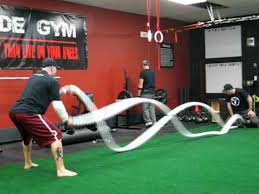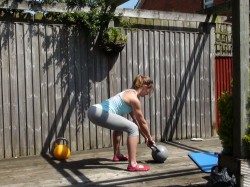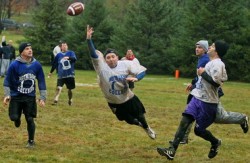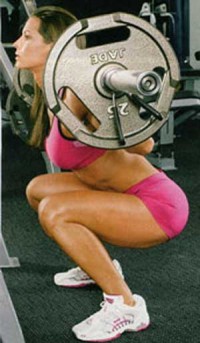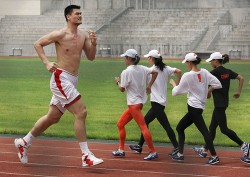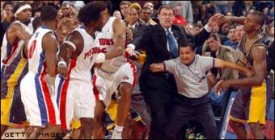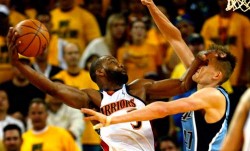Some Of My Favorite Cardio Options
September 19, 2014 by danny · Leave a Comment
This is the longest I’ve gone between blog posts since starting up DannyMcLarty.com. BUT, I’m back! My summer hours were crazy but with high school and middle schoolers back in school, I *should* have some free time to make more frequent posts. At least, I’ll try my best!
The treadmill is not my friend. I have A.D.D. to the 27th power. After about 14 seconds on that thing I start to get panicky, as if I was locked in a small room… GET ME OUT OF HERE! Humans are meant to move, and if getting on the treadmill is something you enjoy, more power to you. Just not for me.
Maybe you’re like me and need to change exercises often to prevent extreme boredom. If so, below you’ll see some of my favorite cardio/conditioning options. Start incorporating one, or all, into your cardio program…
-Battling Ropes – Great low-impact exercise. Even if you have a lower body injury, battling ropes offer a great conditioning tool to work around your injury.
-Heavy Jump Rope – This exercise will get your heart rate up and have your quads burning in no time flat.
-Medicine Ball Jump ‘N Chase – I love this option because it involes deadlifting, jumping, throwing, and sprinting. That’s a big-bang-for-your-buck exercise!
-Sledgehammer Tire Swings – Tough day at work? Kids driving you crazy? This exercise is great for taking your frustrations out! Unleash your fury!
-Plank-Ups – These are really hard. Whenever a member of my gym comes in and sees plank-ups on their training program, it’s usually followed by an eye roll. Hard, but effective!
-Slideboard – Another great low impact option. A unique benefit we get out of the slideboard is the fact that we move laterally (sideways). Most exercise options have us going straight forward. The slideboard helps reduce the chances of overuse injuries since this gets us out of the usual straight forward motion – now we are not performing the same repeative motion over and over and over and over and over again.
-Farmer’s Walks – Another big-bang-for-buck conditioning option. It works your grip, traps, core, and if you choose a heavy enough weight, will really get your heart rate up!
-Boxing - I don’t coach or compete in Boxing/MMA/UFC, so I’m not real concerned about technique (don’t want it to get ugly though). I just use the heavy bag to rapidly raise my heart rate, and like the sledgehammer tire swings, get in to beast mode and go to town! Thrity seconds of all-out effort will make you really tired and definitely give you new found respect for a boxer’s high-level of conditioning!
-Kettlebell Swings – KB Swings are great for working the posterior chain (hamstrings, glutes, low back). They’re also a great teaching tool for learning the hip hinge. Excellent exercise!
-Dumbbell Jump Squats – Another great exercise. Just make sure that you choose a weight that is fairly light… heavy enough to increase the difficulty level of the jump, but not so heavy that it has you slamming down to the ground greatly increasing joint stress. Depending on your strength level, body control, and the amount of reps you are performing, anywhere between 5-25 pounds would probably be a good choice.
-Jump Rope – The simple jump rope was a great choice when TVs were in black and white, is a great option today, and will be an excellent choice in 2054. My powers only go so far… I only have 40-years of future-predicting-ability left in me. But my guess is that our grandkids grandkids will still be using the jump rope.
-Complex – Complexes can have you laying on the floor gasping for air minutes after completion. There are 456,256 different options to chose from. In the example you see above, I’m performing deadlifts, followed by hang cleans, followed by push presses, and finish will back squats.
-Conditioning With A Ball - You knew that I had to include a conditioning option that involved basketball. Any time a sport is played or a ball is involved in a conditioning drill, I’m in! It could be the shooting drill you see in the video, or running pass routes in the backyard with your kids. You get in better shape while having fun. Win-win!
If you dread the idea of performing the same old, same old, hopefully some of these options get you motivated to hit the gym and have some fun doing it!
Did I leave out your favorite(s)? If so, let me know your favorite options…
Q and A: “Is Circuit Training The Best Way To Get In Shape?”
February 19, 2013 by danny · 2 Comments
I received a question from one of my facebook friends the other day asking, “Is circuit training the best way to get in shape?” Of course, like all things training/nutrition related, I had to ask him to get a little more specific to be able to better help him out. The gist of what he was looking for was to find out if to “get in shape” is circuit training best when weight training and when performing cardio? Still pretty vague because there are so many factors that come into play. But here is what my answer was…
“Depends on the goals, the training history of the individual, etc. I know that is vague. But the answer is almost always, “it depends.” If it is an athlete, in GENERAL, I don’t think it is the best way. For example, the best way to get in shape for basketball is to play basketball (the SAID principle – Specific Adaptation to Imposed Demands). And in the weight room, athletes should use weights to get stronger, which requires a bit of rest between sets, as opposed to a fast paced circuit.”
So, I thought I’d use the rest of this blogpost to delve a little deeper into my thoughts…
-For sports, as mentioned above, you must play the sport to get in great shape for your sport. You can do all the sprints, stadium stairs, 400 meter runs, swimming, etc. etc., but if you just stepped onto the basketball court (or soccer field, or football field, or wrestling mat, etc etc) for the first time in weeks/months, and tried to play 35 minutes of real game action, all I can say is, GOOD LUCK! 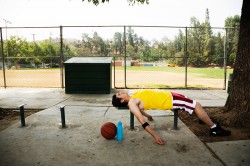
Now, with the above said, I’m NOT saying that you can’t do any conditioning type work other than JUST playing the sport. What I AM saying, is that you must follow that S.A.I.D. principle that I mentioned above and play the sport to get in great shape for your sport. Outside of directly playing your sport, once again the conditioning plan depends on the needs of the sport and position of said sport. But in general, you can include things like… .
…HIIT (High Intensity Interval Training) where you go ALL OUT for a short period of time and then rest. Work to rest ratios can vary, but here are some examples – 20 seconds “on” (all out) followed by 40 seconds “off” (rest) x 10-15 sets. This can be sprints, hill sprints, bike sprints, etc. You CAN do CIRCUIT TRAINING (i.e. 20 seconds of jump rope, then rest 40 seconds followed by 20 seconds of battling ropes, then rest 40 seconds. Followed by 20 seconds of jump squats, rest 40 seconds, etc. etc.).
So circuit training can be a part of the overall plan. But in my opinion should not make up the majority of the conditioning plan (once again, because of the S.A.I.D. principle).
…Tempo Running – run at about 75% max for 75-100 yards and rest 45-60 seconds between reps. Here is what a tempo run should feel like… Fast enough to get the heart going, and slow enough to not hit the lactate system and interfere with power development. For most sports, to bring up your aerobic system you don’t want to go out and run a long distance (i.e. a 5-mile run or whatever). Yes, this will benefit your aerobic system, but will not help (and can actually interfere) with power development (i.e. running faster, jumping higher). Tempo runs are a great way “around” this… you can still bring up your aerobic system without losing out on the potential power gains you get in the weight room.
So, for sport, play the sport and if you still feel the need to add in some extra conditioning, keep HIIT and tempo training in mind. As far as how often you should be adding in conditioning work, that’s impossible for me to say without knowing the situation. I will say this however, I believe that far too many people start worrying about conditioning too soon in the off-season. For more of what I am talking about, check out this youtube video I did on this subject as it relates to basketball players…
Changing Gears To The Person With Fat Loss As Their Main Goal…
I’ll stop here for now, and touch on circuit training for the non-athlete tomorrow. See you then…
Are you a coach or an athlete? If so, share this to help make sure you and others are optimizing your potential and preparing for greatness…
Sample “Finisher” For Your Quads
November 14, 2012 by danny · Leave a Comment
There is more than one way to a skin a cat, when trying to improve a body part. And I’ve found the quads have the most room for “mixing it up.” For example, a couple years ago I went to a bodybuilding show back in California. Branch Warren was the guest poser, and when he got asked the question, “what is your secret to such massive legs?” he looked out to the audience and said with authority, “HEAVY SQUATS.”
I’ve also heard stories of some of the legendary bodybuilders crediting high rep work to bring up their quads (i.e. sets of 25-50 reps). I’ve found that a combination of high and low reps are optimal for maximal quad development.
And as I’ve gotten older, I now tend to shift my focus towards high(er) rep work for the quadzillas. Now, that doesn’t mean ALL I DO is pump out sets of 20-25 reps. But theses days I DO tend to do more sets consisting of 10 + rep sets, compared to sets under 10 reps.
The Two Main Reasons For This?
#1) My quads are as big, or bigger now than they’ve ever been, so high(er) rep sets are working better.
#2) Higher reps sets are generally safer than sets closer to your 1 RM (Rep Max). For example, if you perform a set of 15 reps squats, it is safer than performing a much heavier set of 3 reps.
And more to point #2, I’m no longer a competing athlete, and performance (as far jumping higher and running faster) has taken a back seat to aesthetics and general health as my main focus.
An important note: If you are looking to build your quads in this fashion (higher rep sets and/or finishers like you’re about to see below), it won’t work very well if you haven’t FIRST spent years building up a decent level of strength. So, if you’re an 18 year old newbie and looking to better develop your quads, simply work on getting stronger in lifts such as back squats, front squats, bulgarian split squats, etc. Building a base of strength gives you way more options as your “training career” evolves. So, don’t skip steps.
Below is how I finished my leg workout the other day…
3 words… Quads. On. Fire!
So, in the end, I get to keep my joints healthy (because I’m not always going heavy), keep and even build leg size, and get some great conditioning work in.
So, IF you have already put in your time building a good level of strength, be sure to include some high rep sets and/or finishers for those quads!
Aerobics For Basketball Players?
October 12, 2011 by danny · 2 Comments
Back when I was playing hoops in college, in the pre-season our team was tested in the 1-mile run. I didn’t think anything of it at the time, other than, coach wants to see how good of shape we are in, so I’m going to run this thing as fast as I can. Fast forward a number of years later, and I started to learn more about the body. I learned about different energy systems and which ones are used for particular tasks that we perform when competing in sports, or when working out in general. And as I become more educated, I remember thinking; I wonder why our coach tested us in the mile??? I mean, there is never a point in the game where we run 5 + minutes without a break. Hmm?
Anyway, I now know the mile to pretty much be a pointless test for basketball players. Basically, we sprint up and down the court, get in a defensive stance, chase our opponent around a few screens, box him out when the shot goes up, and sprint down to the other end of the court, run our opponents off a screen or two, and this continues for a bit. OR, a whistle is blown due to a foul, the ball goes out of bounds, a coach calls a T.O., a brawl breaks out in the stands (ahem, Detroit Pistons fans ![]() ), or something similar. Regardless, there is a break in the action very often. So again, none of this even comes close to resembling a 1-mile run.
), or something similar. Regardless, there is a break in the action very often. So again, none of this even comes close to resembling a 1-mile run.
I even touched upon the topic in this article that I wrote a few years back (towards the end of the article where I mention fast-twitch and slow-twitch muscle fibers). Strength Coach Charles Poliquin goes into a little further detail on the matter in his article, “Do Basketball Players Need Aerobics?”
With basketball season right around the corner (except for you NBA – come on, get it together!!!), coaches will be preparing their players with their conditioning program. Most basketball coaches know X’s and O’s, but are not qualified to run an “optimal” strength and conditioning program (understandably, as their time is spent recruiting, running camps, scouting, game planning, preparing for practice, etc etc.). Therefore, I’m hoping articles/blog posts like this will help steer these coaches in the right direction. So, if you are a basketball coach that’s about to start conditioning your players for the season, just remember, that basketball is a sport that is filled with a lot of starts and stops throughout the game.
Testing your athletes or simply conditioning your players with the mile run (or further) is NOT the way to go.
Feel free to forward this on to any b-ball coaches that you know. And don’t forget to check out Coach Poliquin’s article for more information on the topic.
Happy training!
